We’ll take Manhattan
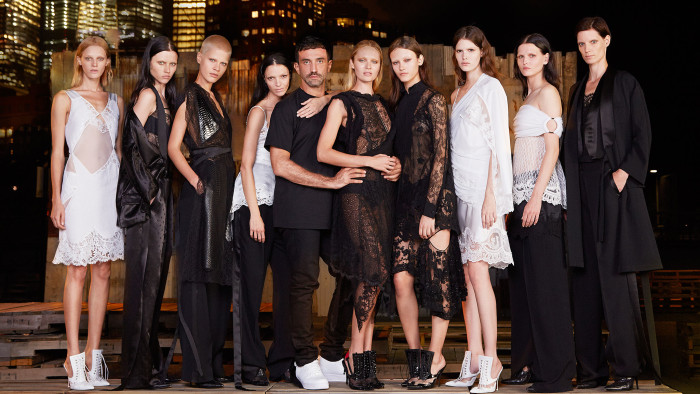
Simply sign up to the Life & Arts myFT Digest -- delivered directly to your inbox.
Last night you held a public catwalk show in New York. Why?
Riccardo Tisci We’re a big family, the fashion family, about 2,000 in the world, but I don’t understand why the shows shouldn’t be for real people. Privacy is fun but I don’t like its snobbishness. And people want to be part of it. The show was a celebration of life. I devised it with [the artist] Marina Abramovic and we staged it on September 11.
[The attacks] didn’t just touch people from America — the world stopped for a second. My intention was to do a show, a real show, about love and allegiance, where everybody would be at the same level. We wanted it to be strong and surprising — it’s my idea of a woman playing with masculinity but it’s very couture, very Parisian.
Why not an American themed show?
RT I didn’t want to make it an American collection, I wanted to bring my style and identity. So I went full-on — with all my obsessions with metallics and masks and face jewellery. It was themed around a wedding. The clothes are quite deconstructed: just black and white with beige, with menswear and couture in the middle. Marina’s side was more about love and hurt and energy.
The name of the show is #love because that’s what it’s about. Two years ago, when I started on Instagram, I always put #love, #Instagram, #gang, and everyone laughed and told me it was ridiculous. But I like it.
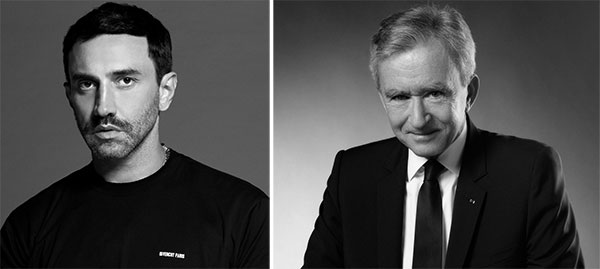
I’m into family, I’m into love, I’m into gang. We all live for love; love is the only thing that doesn’t have a prize, a religion. It’s what puts everybody on the same level, and that’s the point of this.
Marina made this big statement four years ago that she was adopting me, spiritually; she asked my mum. We met when we were both heartbroken, a strong moment, and we fell in love like mother and son, brother and sister.
So for you it’s about accessibility?
RT Yeah. We have Instagram and Facebook and everything but it’s not the same. Pictures and videos don’t give the emotion. We expected 4,000 people but more like 6,000 saw the show. We had 25,000 people registering for 850 tickets; 2,000 of those were in the first two seconds. We gave 150 tickets to people of the local West Side community and had big screens on which it was broadcast live across the city. Whoever was seeing the show could be from any walk of life — any district, any business. And, to my understanding, we’ve been one of the first brands to do it in such a way.
Why go to New York, when Givenchy’s home is Paris?
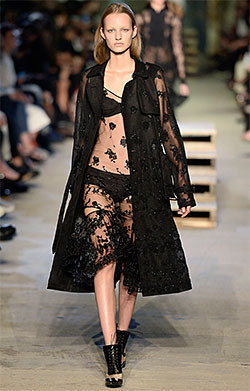
Bernard Arnault For several reasons. New York was very important for Hubert de Givenchy in the 1950s. He opened the shop on the Upper East Side and his style was influential in the US. He was close to Audrey Hepburn and he designed for Jackie Kennedy. The US is as important for Riccardo — he’s influenced by New York and the mix of high fashion and street fashion, and the show was a combination of that.
RT I’ve been obsessed with America since childhood, and by its music and symbols: Marlboro, McDonald’s, Coca-Cola. I’ve been collecting American flags since I was 16. Historically, for Europeans, it is where everyone can express themselves and become someone. Italians are obsessed with America; the French won’t admit it.
My father died young. His dream had been to bring my mother to America. I grew up with this in my conscience. I was stuck in a cage in my country and though I love Italy, 30 years ago if you were poor there, your destiny was to remain so. When I started working with Marina [who is based in New York], and Givenchy had become recognisable and strong, I still had my dream of America, so we thought: why not, let’s go!
Did you worry about the reaction?
RT Usually I don’t. If I did I’d have given up my job because at the beginning of my career everybody thought I was useless. I was the bad man of fashion — the dark one, the one obsessed with sex. But I was scared with this [show] — not that they’d judge me on my work, or judge Marina — I just hoped nobody would misunderstand me because it was September 11. And you know me, I’m not a safe designer, I’m not doing simple clothes . . . It was very emotional. A show of love on a memorial day.
Did you think it was a risk taking the show from Paris to New York?
BA No. We are entrepreneurs so we like risk. It’s part of life.
This is one of several huge off-schedule events staged by LVMH this year. Is this the future of the fashion show?
BA This was the biggest show of its kind this year. Perhaps ever. I think the goal for the shows is still to present the collection, as viewed by the designer, to the consumer and the press. John Galliano, who was once at Givenchy, started this way of presenting clothes while he was at Dior at the end of the 1990s. He added an element of surprise, of fun, of music, to the pure presentation of clothes and the collection — to create a spectacle. He had a sense of show and others followed.
Does last night’s event mark a new phase in showmanship?
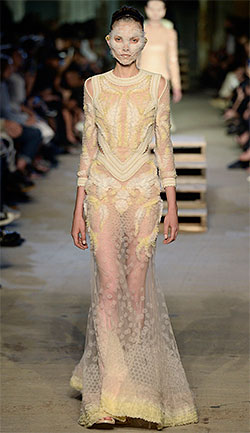
BA I don’t know . . . It’s a big one-off. I don’t think we’re going to do that every year. But it shows the commitment to the brand — from Riccardo, from all of us — and how, after 10 years, it’s one of the most successful labels today.
RT I think it would be beautiful next season to show in the streets of Paris, where 5,000 people could watch it.
Is there commercial benefit to showing in a massive public space like Pier 26?
RT This is not about us showing off with power and money, about being bigger than everyone else. The location was designed by Marina and myself with recycled wood and metal. It was honest, a real collection. This was about everyone being allowed to see what we are doing; a beautiful present to people.
BA Hubert de Givenchy was connected with the most influential and high-end customers but he was also very connected to the public. Riccardo, in a different way, is doing the same thing.
How do you honour Givenchy’s DNA?
RT I don’t know why Mr Arnault chose me for Givenchy. I didn’t want to do it to begin with: Givenchy to me was Audrey Hepburn and Breakfast at Tiffany’s and I didn’t understand it. I accepted to help my family financially. But Mr Arnault saw something in me; nobody else saw it, everybody thought I was wrong.
But, I discovered when I went into the archives, Givenchy is more than a cocktail dress: it’s ironic, aristocratic, severe, Parisian and, more than anything, dark. The emblematic looks of the house are all black. When I first did black, everybody thought I was the Antichrist. But the bestsellers are always black.
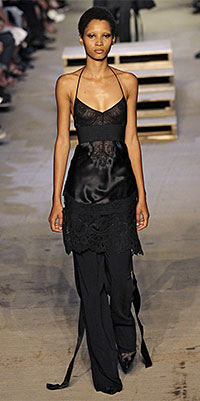
We were in profit within four years. And then, with time, the corset jacket became a tuxedo and the cocktail dress became the Bambi sweatshirt and the Rottweiler motifs. I translated elements into what women want to wear today. I’ve made things that have become very Givenchy (or very Riccardo Tisci): when you see stars, you think about me; when you see print, you think about me; when you see animals, you think about me. Religion, piercings, metal — it’s very me.
What’s behind Givenchy’s success?
BA Riccardo has brought the youth to Givenchy. He’s brought a different vision of fashion. He’s revived it in keeping with Hubert de Givenchy’s spirit; it is still refined and elegant but he brings his own personality and creativity to it. That, I think, is the big achievement. Today, Givenchy is a symbol of modernity and creativity but it’s still very much related to the founder. When a brand like that is successful it’s because the designer is able to interpret his vision in connection with the label. It doesn’t always work. Here, it’s working.
Is this engagement with youth essential for a luxury brand?
BA You have to build for the future and the brand has to be meaningful for the young. I have seen lots of kids wanting to relate to — and being interested by — creativity. Obviously they can’t all buy into it because it’s expensive but they like to see invention — which you do not find in very affordable brands because most of it is a cheap copy. But the young make a difference — we can sell out of a product on the net in hours.
RT I’m a very good merchandiser, that is key to the success of my career. We now have a team of merchandising people but for eight years I did it myself. I’m obsessed with prices — how much is it? How can we make it cheaper?
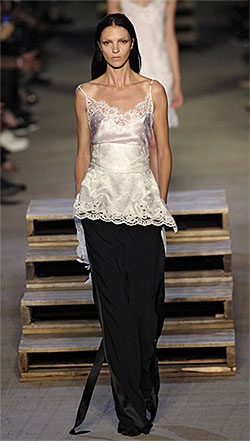
I understand the strongest pieces, so the moment the collection is done I ask the commercial and production people how much the look will cost and, if necessary, amend the design to fit the price point. Twenty per cent of the collection has to be sellable. In a look I’d probably have a jacket that is expensive but the trousers, the waistcoat and the T-shirt will be entry-price. I have my couture, and we have clients who can spend €200,000 on a dress, so my dreams can be expressed.
Where does Givenchy go next?
RT I’m ready to build the Givenchy lifestyle. I’ve started doing stores [a Tisci-designed store opened on Madison Avenue recently, and a Milan store will officially open during Milan Fashion Week]. A lot of things are coming out soon: I’ll be collaborating with the perfume; I’d like to do objects and more buildings.
We’ve built a brand that works for two generations; that’s why the stores are designed like a house, with a younger room — with the sneakers, backpack, Bambi jumpers and Rottweiler hairbands — but also further rooms where a more mature woman will find a crocodile bag and an evening dress.
Givenchy’s American clients transformed his international reputation. Do you feel a similar sense of debt?
RT America got with the clothes early on; one of my first big supporters was Barneys. The American press did not get me at all but the retailers went like that [clicks fingers]. And Americans were the first people to support me — like Madonna and Courtney Love.
BA It’s the number-one market; it has always been, and so we’re very committed to the US. We think the growth is there; it’s the reason we invest there. We open shops, we have a lot of people working for us in the country, and we are very successful in many areas.
And who is the aristocrat in today’s Givenchy?
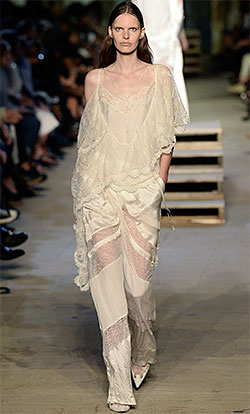
RT All my couture clients: women like Cate Blanchett, Julianne Moore, Rooney Mara, Marina Abramovic, Julia Roberts. I have that side. I have also Kim Kardashian, Madonna, Beyoncé . . .
There’s the castle and there’s the street. You need to have both. You need to feed elegance; you need to feed the street. Kim Kardashian is the queen of the decade for me. I got killed four years ago when I made all the clothes for [her] wedding. But I didn’t care because I could see that she had something . . . For me, Kim was edgy but real. She was what society wanted and she sells like hell on the cover of a magazine.
The show was a nice way of LVMH saying, ‘We’re behind you.’ Does it mean you won’t be leaving any time soon?
RT Leaving for another company for more money or more power is not my thing. This house has a good energy and a good karma; I’m happy here and it’s become my house. Of course it’s not my house because I don’t own it, but it’s got a new life. I want to sell clothes and I want to sell bags and I want to sell dreams. I don’t want to become a supermarket and with that Mr Arnault has been respectful of me, he has let me do what I want. He knows that I’ve had moments where people have doubted me, when I’ve shocked people with my decisions. But any time I’ve taken a risk, he’s supported me. Even when I wanted to do this crazy show in New York.
Photographs: Alfredo Piola for Givenchy; Danko Steiner; Karl Lagerfeld; Catwalking.com
Comments